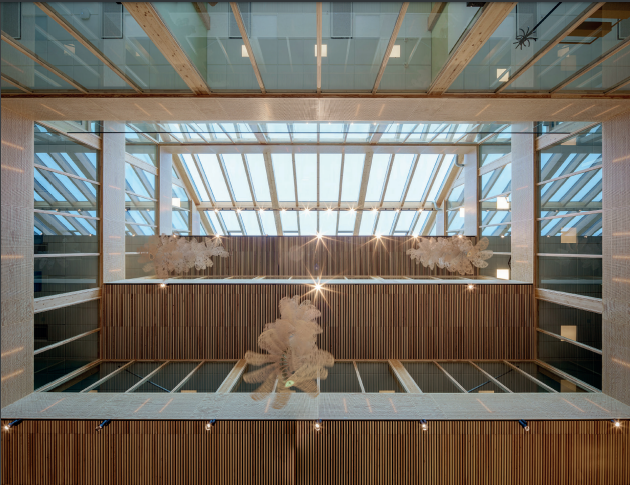Växjö Town Hall and Train Station: sustainable, functional, and inviting
The iconic new railway station and public building won the Highly Commended prize for the 2022 Best Use of Certified Timber Prize, supported by PEFC.
Växjö Town Hall and Train Station: sustainable, functional, and inviting
16 February 2023 Sustainable construction
The university city of Växjö is home to one of the largest timber buildings in Sweden, using 100% PEFC-certified timber. The iconic new railway station and public building won the Highly Commended prize for the 2022 Best Use of Certified Timber Prize, supported by PEFC.

Responding to a growing population and increased tourism, the new mixed-use, seven-storey building combines municipal areas with a modern transport hub all under one roof.
When the Växjö station area was first developed in the 1870s, it was built for a city of 4,000 inhabitants. The population is now over 65,000, which required the Växjö station area to undergo a major upgrade to make it fit for purpose.
Sustainability at heart

Växjö has been named ‘the Greenest City in Europe’ because of its long-term commitment to low carbon construction. In keeping with the long-held local approach to greener buildings, the project adopted a sustainable approach right from the initial planning stage.
Binderholz supplied 1,100 m³ of PEFC-certified glulam and 3,100 m³ of PEFC-certified cross laminated timber (CLT) for the building. The gross area of the building is almost 17,000 m2.
The interior has many visible timber elements including suspended ceilings, wall coverings, floors and stairs. The building will also benefit from 577 m2 of solar panels installed on the roof to provide renewable energy.
The building is also certified to the Swedish Green Building Council’s gold environmental certification (Miljöbyggnad Guld), which looks carefully at materials used and energy consumption.
The use of structural timber meant a lower environmental impact than competing materials such as concrete or steel. In addition, the use of timber allowed for a cleaner and quieter construction.

The train station is at the ground floor entrance level and is connected to the railway bridge upstairs. The central areas of the building on the first two floors are open to the public.
The station also has shops, cafés and restaurants as well as a 780 m² meeting-space, dubbed the ‘Växjö living room’.
The outer walls to the north and east are made of timber, which are part of the structural frame.
The facade on the street level consists of wood panelling in both natural and dark colours. Floors four to seven house the town hall’s administrative centre, with about 600 workplaces.
In collaboration with Skanska, project architects Sweco worked on the overall design, while other architectural firms including White Arkitekter worked on the town hall’s interior and the shops in the station.
“As architects, we believe that buildings and cities show the kind of society we want to live in and Växjö station and town hall is a good example of this,” said Niklas Kummer from Sweco, the architect responsible for the project.
“The town of Växjö is particularly distinguished by its unique location in the forest and therefore Växjö station and town hall is rooted in the local tradition. We are grateful that we have been able to participate in this project, we believe that wooden buildings are the future.”
Photos © Felix Gerlach